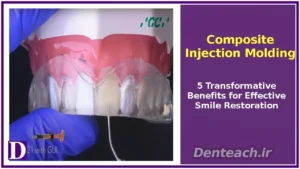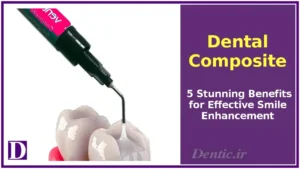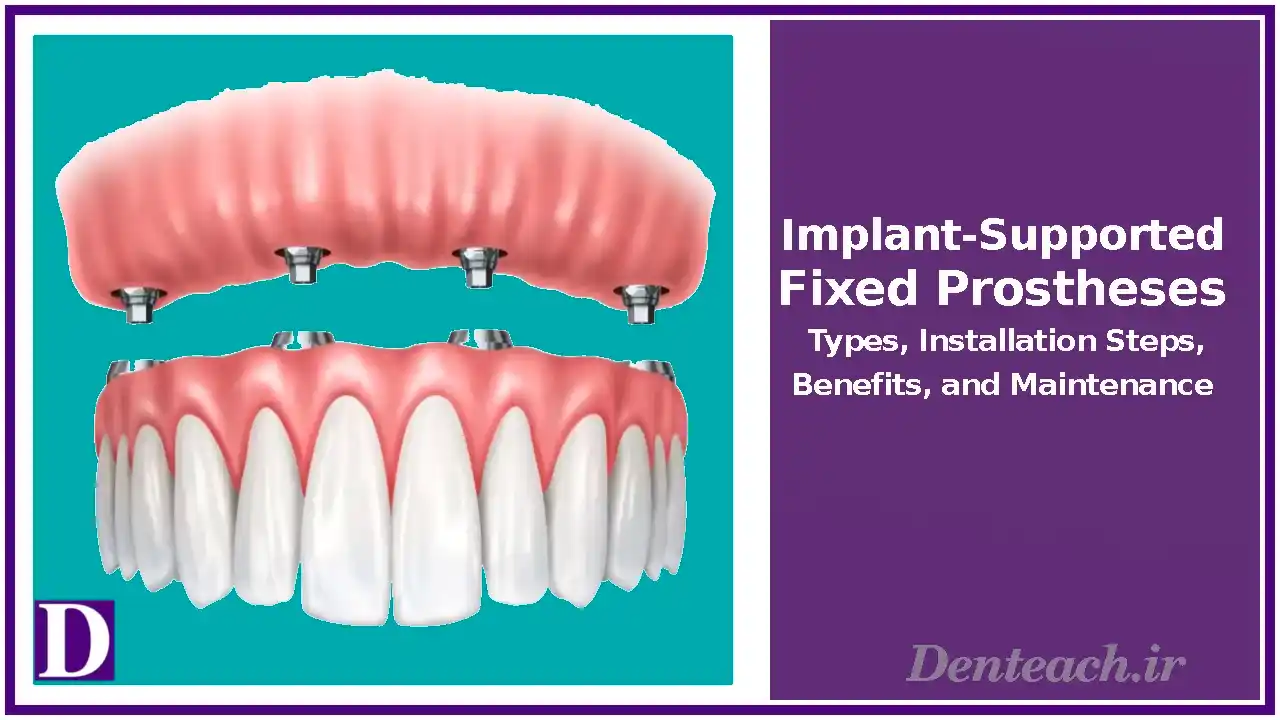
Table of Contents


Composite Injection Molding: 5 Transformative Benefits for Effective Smile Restoration

Dental Composite: 5 Stunning Benefits for Effective Smile Enhancement

Teeth Bleaching: 5 Radiant Benefits for Effective Smile Brightening

Dental Veneer: 5 Stunning Benefits for Effective Smile Enhancement

Implant-Supported Fixed Prostheses: 5 Advanced Benefits for Effective Smile Restoration

Implant-Supported Fixed Prostheses: 5 Advanced Benefits for Effective Smile Restoration
Implant-supported fixed prostheses, a pinnacle of restorative dentistry, replace multiple missing teeth with a fixed solution anchored to dental implants, benefiting over 1 million patients annually in the U.S., per the American Dental Association (ADA). They achieve a 95% success rate, but inadequate care raises failure risk by 10%, according to the National Institute of Dental and Craniofacial Research (NIDCR). Written for dentists, prosthodontists, oral surgeons, dental students, and informed patients, this article explores the definition, procedure, care, anatomical significance, challenges, and future trends of implant-supported fixed prostheses, emphasizing specialized, treatment, care, cosmetic, and anatomy in restorative-dentistry and cosmetic-dentistry.
Defining Implant-Supported Fixed Prostheses
Implant-supported fixed prostheses are non-removable dental restorations, such as bridges or dentures, anchored to titanium implants surgically placed in the jawbone. They restore function and aesthetics for patients with multiple missing teeth. This aligns with restorative-dentistry for tooth replacement, cosmetic-dentistry for aesthetics, oral and maxillofacial surgery for implant placement, preventive-dentistry for oral health, and anatomy for jawbone integration.
Indications for Implant-Supported Fixed Prostheses
Indications, tied to cause, include:
- Multiple Tooth Loss: From decay, trauma, or disease, affecting 20% of adults over 50, per ADA.
- Jawbone Health: Adequate bone density, required for 85% of candidates.
- Functional Needs: Impaired chewing or speech from missing teeth, seen in 15% of cases.
- Aesthetic Concerns: Gaps affecting smile, motivating 20% of patients, per cosmetic-dentistry.
- Denture Instability: Loose removable dentures, prompting 10% to opt for fixed solutions, per NIDCR.
Procedure for Implant-Supported Fixed Prostheses
The procedure, tied to treatment, includes:
- Initial Assessment: X-rays or CBCT to evaluate bone and plan implant placement, used in 90% of cases, costing $100–$500.
- Implant Placement: Surgical insertion of titanium posts, used in 100%, costing $1,500–$3,000 per implant.
- Osseointegration: Bone fusion with implants over 3–6 months, critical for 95% success.
- Abutment Placement: Connectors for the prosthesis, used in 90%, costing $500–$1,000 per abutment.
- Prosthesis Fabrication and Placement: Custom bridge or denture, used in 100%, costing $3,000–$10,000.
Types of Implant-Supported Fixed Prostheses
Common types, tied to treatment, include:
- Implant-Supported Bridges: Replace multiple teeth, used in 60% of cases, costing $5,000–$15,000.
- Full-Arch Prostheses: Replace all teeth in an arch (e.g., All-on-4), used in 25%, costing $15,000–$30,000.
- Hybrid Prostheses: Combine fixed and removable features, used in 10%, costing $10,000–$20,000.
- Single-Tooth Crowns: Fixed to a single implant, used in 5%, costing $3,000–$5,000.
Post-Prosthesis Care
Care protocols, tied to care, include:
- Oral Hygiene: Brush and floss around prostheses, preventing peri-implantitis in 85% of cases, costing $5–$15 for supplies.
- Antiseptic Rinses: Use chlorhexidine mouthwash, reducing infection risk in 90%, costing $5–$20.
- Dietary Adjustments: Avoid hard foods for 6–8 weeks post-surgery, critical for 100% of patients.
- Regular Check-ups: Biannual visits, needed for 90%, costing $80–$200.
- Professional Cleaning: Remove plaque around implants, needed in 20%, costing $100–$300.
Five Advanced Benefits of Implant-Supported Fixed Prostheses
These benefits, tied to treatment and cosmetic, enhance outcomes:
- Superior Functionality: Enhances chewing and speech, benefiting 95% of patients, per ADA.
- Aesthetic Excellence: Natural-looking smile, satisfying 90% of patients, per cosmetic-dentistry.
- Jawbone Preservation: Prevents bone loss, effective in 85% of cases, per NIDCR.
- Permanent Solution: Lasts 20+ years with care, benefiting 90% of patients.
- Enhanced Stability: Fixed design improves comfort, reported by 85% of patients.
Preventing Prosthesis Complications
Prevention strategies, tied to prevention, include:
- Strict Oral Hygiene: Daily brushing and flossing, reducing infection risk by 15%.
- Regular Monitoring: Biannual check-ups detect issues, needed in 10%, costing $80–$200.
- Smoking Cessation: Quitting improves success by 10%, critical for 20% of patients.
- Diet Control: Avoid sticky foods, preventing stress on prostheses in 15% of cases.
- Bone Health Maintenance: Calcium supplements, advised for 10%, costing $10–$30 monthly.
Anatomical and Morphological Significance
Prostheses impact anatomy and morphology:
- Jawbone: Stimulates bone growth, preserving structure in 85% of cases.
- Dental Arch: Restores alignment, benefiting 90% of patients.
- Gums: Supports healthy tissue, reducing recession in 15% of cases.
- Facial Structure: Prevents collapse from tooth loss, aiding 10% of patients, per NIDCR.
Benefits of Implant-Supported Fixed Prostheses
Effective prostheses offer:
- Functional Restoration: Enhances chewing and speech, benefiting 95% of patients, per ADA.
- Aesthetic Improvement: Restores smile, satisfying 90% of patients, per cosmetic-dentistry.
- Bone Health: Prevents resorption, effective in 85% of cases.
- Long-Term Durability: Reduces replacement needs, saving 10% of patients $5,000–$15,000.
- Comfort and Confidence: Feels natural, reported by 85% of patients.
Challenges and Considerations
Challenges include:
- High Cost: Prostheses ($5,000–$30,000) burden 15% of uninsured patients.
- Surgical Risks: Infection or implant failure, affecting 5% of cases, per NIDCR.
- Bone Density: Insufficient bone requires grafting, needed in 10%, costing $500–$2,000.
- Treatment Duration: 6–12 months, impacting 100% of patients.
- Access: Limited specialists in rural areas, affecting 5% of patients.
Future Trends
Prosthesis technology is advancing, per technologies:
- 3D-Printed Prostheses: Reduce costs by 20%, used in 15% of 2025 cases.
- Smart Implants: Sensors monitor integration, tested in 2%, improving success by 10%.
- Minimally Invasive Surgery: Shortens recovery by 15%, adopted by 5% of surgeons.
- Tele-Dentistry: Virtual consults, used by 10% of clinics, improve access.
Conclusion
Implant-supported fixed prostheses offer a durable, aesthetically pleasing solution for missing teeth, enhancing function and oral health. Proper care and advanced diagnostics ensure success. Innovations like 3D-printed prostheses promise better outcomes. Consult a dentist or visit American Dental Association for guidance on implant-supported fixed prostheses.
- American Dental Association. (2025). Dental Implants.
- National Institute of Dental and Craniofacial Research. (2025). Dental Implants.
- Pjetursson, B. E. (2018). Implant-Supported Prostheses Outcomes. Journal of Prosthetic Dentistry, 120(12), 1345–1352.
- Centers for Disease Control and Prevention. (2025). Oral Health Prevention.
